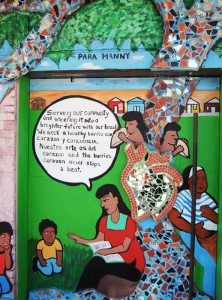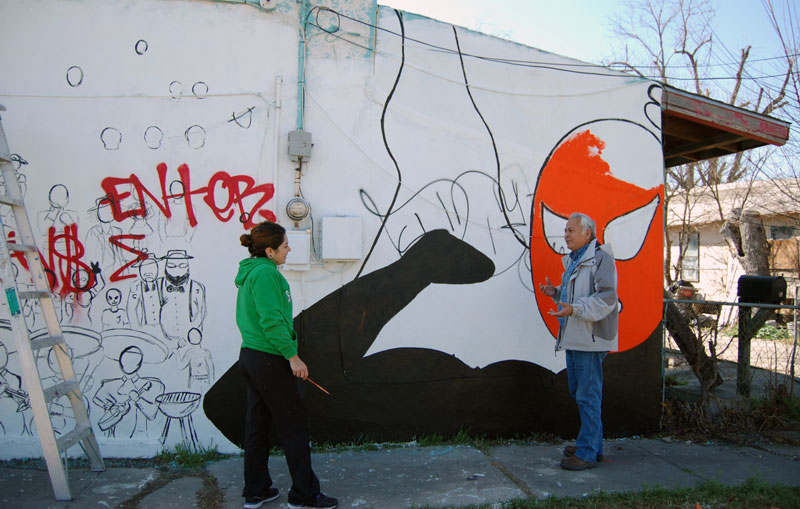“Come together as a community”: An Interview with Harvey Mireles on San Anto Cultural Arts
by Joshua Barnes / May 15, 2014 / No comments
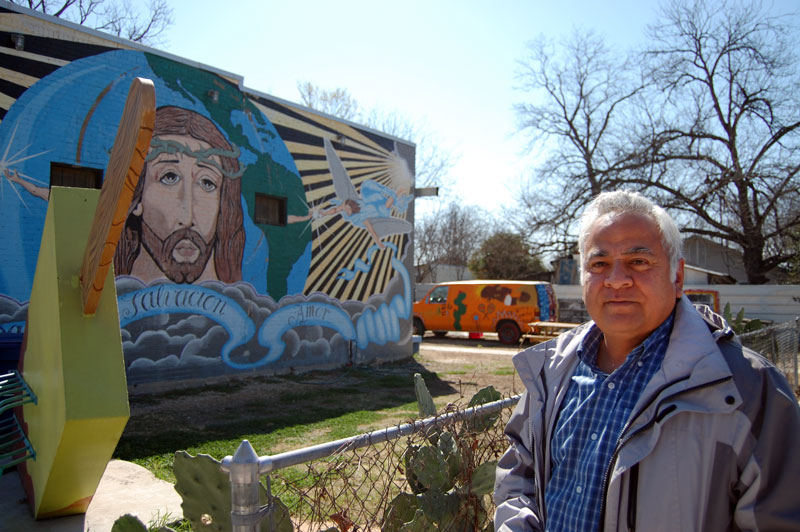
Harvey Mireles, Executive Director of San Anto Cultural Arts at 2120 El Paso St. San Antonio, TX. Photos: Joshua Barnes.
Just two blocks north of Guadalupe Street, the main road that runs through San Antonio’s West Side, sits San Anto Cultural Arts, a non-profit organization that helps people of all socio-economic backgrounds realize their creative skills in art, journalism, and video production. Situated between ranch houses on a quiet, tree-lined street, it’s not uncommon to see chickens and small dogs scurry out of the road and through its front yard as cars cruise by. A bicycle rack shaped like a dripping paleta pokes out of the lawn and a mural-mosaic that reads “Nuestro arte es del corazon, and the barrio’s corazon never skips a beat” adorns the front edifice. Another mural entitled “Salvación” is painted on the right side of the building.
This one-room, 400 square-foot building is San Anto’s base of operations. It serves as an administrative office, mural studio, workshop, computer lab, classroom, and the headquarters of El Placazo community newspaper. When Sampsonia Way visited San Anto one Wednesday morning in February a young artist was reviewing designs for a mural she was painting on a house across the street while another scanned and archived rare woodcut prints that had been recently donated to the organization.
Harvey Mireles is the new executive director of San Anto Cultural Arts. With his shock of thick white hair and gregarious personality he is leading the organization through several waves of change after the passing of its founder Manny Castillo in 2009. In this interview Mireles discusses his history with San Anto, the organization’s growth in the last year, the importance of their mural program and El Placazo, and why all of San Anto’s community programming is free and open to the public.
How did you start working at San Anto Cultural Arts?
I’m from the West Side—just up the street—and in 1996 when I was home on leave from the Air Force I came across a copy of El Placazo community newspaper for the first time. I thought, “I’m from here, but here’s this newspaper I didn’t know about,” and I wanted to meet the people who were behind it. That lead me to Manny Castillo, the founder of San Anto Cultural Arts. We stayed in touch over the years and I helped out wherever I could.
In early 2012 I’d been on the board for about six months and we were trying to hire a new executive director, but it wasn’t panning out. The community wasn’t happy either. I thought I could do more, so I resigned from the board and threw my name in the hat for the position. Here I am today, honored to be able to follow in Manny Castillo’s footsteps and continue the vision that he had for the organization.
Manny Castillo seems to have had an important influence on you. What was it like to meet him in the 1990s? What was the organization doing at that time?
Whenever I was home, I would visit Manny. I met him for the first time in 1996 at 1300 Chihuahua Street, which is where San Anto was at the time, but it was called the Inner City Cultural Arts Program then, based under a nonprofit called Inner City Development. Manny was such an interesting guy. He had a mission to make a difference in this community and he told me that he was planning on creating a nonprofit independent of Inner City. He didn’t tell me what the organization’s name was, but he pointed to the building next door and said, “I’m going to be officed right here.”
He started in that nine-by-nine foot space, but he always had plans to move next door into the 400 square-foot space. Still, San Anto functioned out of that small building until we moved here in 2010. We purchased the building we’re in now in 2009 and Manny passed away in the same year. He didn’t get to see us move in, which is a shame because he always had his eyes on this building—even though I wish he had his eyes on a larger one [laughs]. We’re now in the process of adding a 1500 square-foot expansion that will house a new computer lab with 20 PCs for El Placazo and a new mural studio.
With the many changes that San Anto has been going through, what difficulties have you faced?
Manny Castillo’s loss was hard; he left some big chanclas to fill, and it’s tough to follow his footsteps. He’d been with the organization since the beginning, for over 15 years. When we lost him, we also lost a degree of confidence and some of the organization’s followers. When I took over, I had my work cut out for me because that loss of confidence had translated into funding opportunities that went by the wayside. Organizations, foundations, and individuals wanted to wait for us to stabilize before they saw San Anto as worth funding again. Now I think we’re there. This past year was very successful, and it seems like every other day we’re in talks with another organization or group or school about collaborating on programming.
Today one of our biggest challenges is recruitment. We’re always looking for new ways to recruit youth. In previous years we’ve documented about 178 youth participants, but last year we provided services to some 369 youth in over 30 different projects that included six Placazos, a number of murals, some sculpture building, a dumbo press that we created, and Fotoseptiembre. We’re still trying to grow—this year I want to hit 400 participants.
What challenges are there for kids who live in San Antonio’s West Side and how does San Anto address them?
There’re a lot of challenges for the youth in this community. I know firsthand that the resources are limited. Quite honestly, we’re in the belt buckle of poverty in San Antonio, so the means are very limited for the kids and for the parents. There’re also challenges at home that confront the youth that we serve.
We address the broader situation with our programming, but often times those opportunities can cost a lot for some kids, and that’s one of the things that San Anto does well. We don’t charge for any of the programming that we do. We find ways of financing our projects so there’s absolutely zero cost for the youth. In addition, there’s zero cost for the artists that partner with us. If we have an event, there’s no charge for booths or application fees or anything like that. We try to come together as a community.
The other issue that’s confronting this immediate area is illiteracy. As far as the illiteracy that persists in this city, we’re ranked 73 out of 77 in the nation. We’re plagued with literacy challenges, and a lot of the basis for that statistic comes from right here on the West Side. To work against that we have El Placazo community newspaper, but we’re quickly finding that these kids have reading, spelling, and writing problems that we have to address first, so we’ve made it a point to collaborate with other organizations to help them improve those skills.
Is El Placazo primarily a youth-oriented program?
It’s primarily about youth, but we do have adult contributors as well. Everyone can have something to say in El Placazo. Inmates in the Bexar County Correctional system also send us writing to consider for publication. These pieces talk about what they’ve been through and how things may have been different, or what they plan on doing, or sometimes it’s just a message back to the community. For the most part El Placazo is a forum for any social issue or concern. It’s an opportunity to brag about something, to publish your kid’s picture, or to share your daughter’s Quinceañera.
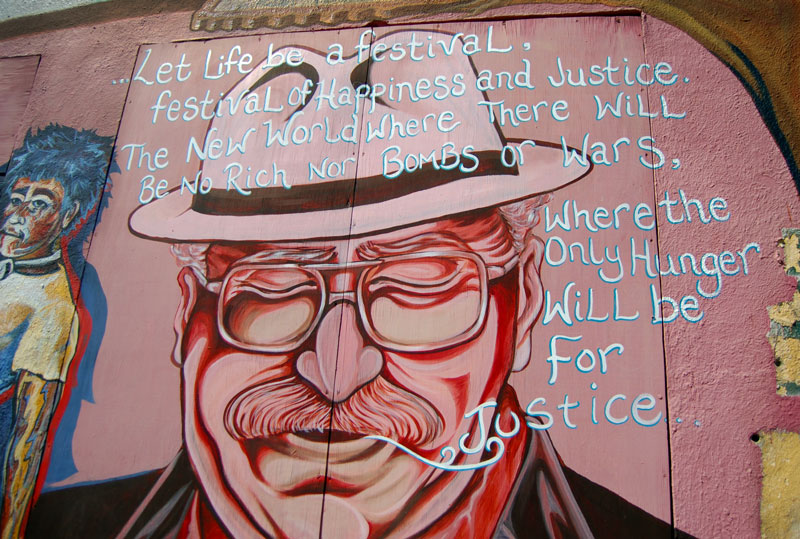
Detail of 'Lideres en la Comunidad' mural outside of the National Association of Latino Arts and Cultures offices.
The Public Art Program is also an integral part of the organization. What does it do for the community?
We’re primarily known for our murals and have created 47 murals in over 20 years. Granted, Community Cultural Arts Program was creating murals long before San Anto began doing it. They were doing it primarily in housing projects in the West Side and were pretty darn good at it. That program eventually went away, but people wanted to see it continue and we saw the advantages—it was focused in housing projects and involved the youth—so San Anto decided to continue that engagement. That was in 1993. At the same time, the community had other challenges of gang violence, prostitution, and drugs; there was a lot more of that then than there is today. This community has improved a lot in the last 20 years, and I think the artwork, or the opportunity to create murals and be involved in a program, did a lot towards improving life for the youth and families, and definitely for this community.
How have the murals changed things recently?
Just the other day, a reporter asked me, “Why are you here? Why is San Anto here on the corner of Chuparedas and El Paso?” It’s because this is where the task is. This is where the mission is needed. Our mission is written right up there on the wall above the door: “To foster human and community development through community-based arts.” Our mission is engaging the community.
Take for example the “Respect Your Barrio” Mural that we’re painting on the house directly across the street. The family that lives there had people tagging the sides of their home and it just kept getting worse and worse until it became a tagging war. The family approached us and asked if we would create a mural on their house and we said of course.
We’ve created a number of murals in this immediate area and while we typically do things a little differently, in this case we’re right across the street so we take the kids over after school and they work on improving their neighborhood directly. The mural is also about asking our community to take a more active part in what’s happening in the neighborhood, so it’s a great thing for everyone.
How has the National Association of Latino Arts and Cultures (NALAC) contributed to the success of San Anto Cultural Arts over the years?
NALAC is a funder whose funds go to one of our and their core goals: Contribute to the advancement of artists and cultural arts. We’re fortunate to have NALAC in San Antonio and their efforts extend to influencing local city policy when it comes to fair distribution of funding to arts organizations.
How do you chart success for the organization?
My professional background is as a technologist, so I literally gauge it with data. Data is very telling about where we’re at and where we need to be, if we’re going in the right direction, and whether we’re having an effect or not. It helps us understand how to adjust our programming to get the effect we want.
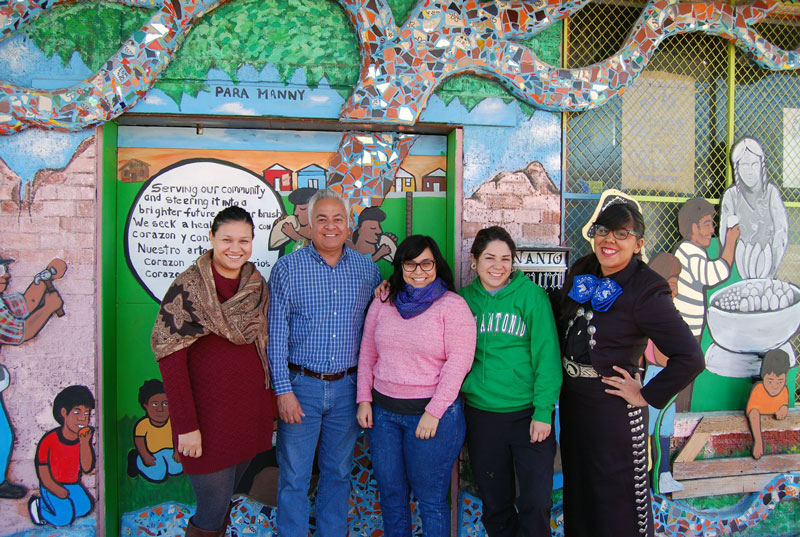
Left to Right: Samantha Rae Lopez, Harvey Mireles, Mari Hernandez; Artist: Adriana Cantu; Volunteer: Erika Gonzales.
Where do you see San Anto Cultural Arts in the next five years?
Five years is a blink. There’s a lot to do here. Literacy will be a key component of the organization. It has to be. As a community, our high school success rate is not where it should be, so we’ve got to do what we can to help those numbers go in the right direction. Still, we are San Anto Cultural Arts and I want to make sure we’re not losing sight of that. I want to give opportunities to other forms of art, whether it be abstract, or more contemporary pieces, or sculpture. San Anto should be a place where artists can go and get support for a project. We also need to ask ourselves what else San Anto can bring to the community. Through our partnerships with other arts organizations I know we can help make this area of the West Side a nationally-respected cultural arts district that I’ll now start calling the Guadalupe Cultural Arts District.

